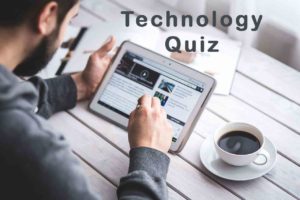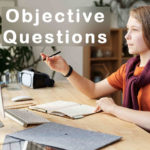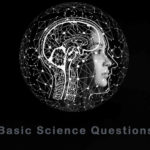Technology Quiz Questions and Answers 2020

COMPUTERS AND TECHNOLOGY – Technology Quiz Questions Part 1
Computer chips host websites composed of HTML and send text messages as simple as…LOL. Hack into this quiz and let a chip tally your score and reveal the contents on your computer screen.
1) How many computer languages are in use?
A) 2000
B) 5000
C) 50
D) 20
Answer: 2000
There are about 2,000 computer languages in active use, whereas there were only 15 in use in 1970.
2) Which of these is not an early computer?
A) ENIAC
B) UNIVAC
C) NASA
D) SAGE
Answer: NASA
NASA stands for the National Aeronautics and Space Administration. It is an agency of the U.S. government.
3) Who founded Apple Computer?
A) Stephen Fry
B) Bill Gates
C) Steve Jobs
D) Stephen Hawking
Answer: Steve Jobs
Steve Jobs founded Apple Computer with Steve Wozniak and another partner in 1976. Jobs became the chairman and CEO of Apple in 1996.
4) Which of these is not a peripheral, in computer terms?
A) Keyboard
B) Monitor
C) Mouse
D) Motherboard
Answer: Motherboard
A peripheral is a device that attaches to a computer. The motherboard is within the computer and controls its ability to receive and process electronic signals.
5) Which of the following is not one of the early “protocols,” or ways to use the Internet?
A) Blogging
B) Telnet
C) Gopher
D) FTP
Answer: Blogging
The early use of the Internet relied on protocols for transferring files or remote control of other terminals. Blogging did not emerge until later, in the 1990s.
6) What does the Internet prefix WWW stand for?
A) Wide Width Wickets
B) World Wide Web
C) Worldwide Weather
D) Western Washington World
Answer: World Wide Web
The World Wide Web dramatically increased the use of the Internet. Tim Berners-Lee established the convention in 1989.
7) A network designed to allow communication within an organization is called:
A) the World Wide Web
B) Yahoo
C) an intranet
D) the Internet
Answer: an intranet
An intranet is a private computer network, usually within an organization or group and is limited to its members for sharing information.
8) Which of these is not a kind of computer?
A) Apple
B) Lenovo
C) Toshiba
D) Lada
Answer: Lada
A Lada is a kind of car manufactured in Russia. The others are brands of computers sold worldwide.
9) Which of these products is not made by the Apple Corporation?
A) IMAX
B) iPhone
C) iMac
D) iPod
Answer: IMAX
The IMAX, which stands for “Image Maximum,” is a large-screen motion picture technology invented in Canada.
10) What is the name for a computer pointing device?
A) A Mouse
B) Sound Card
C) Ram
D) Monitor
Answer: A Mouse
A mouse allows a computer user to move to different parts of the screen without a keyboard.
ELECTRONICS & GADGETS QUIZ – Technology Quiz Questions Part 2
Who is the maker of the iPhone? In what year was the DVD introduced? The iPod? Scan these questions and test your knowledge of electronics and gadgets.
11) Who invented flexible photographic film?
A) Leonardo da Vinci
B) Linda Eastman
C) Louis Daguerre
D) George Eastman
Answer: George Eastman
In the late 1800s the U.S. inventor George Eastman invented flexible film and a small, easy-to-use camera. These made it possible for anyone to take photographs.
12) When did the compact disc first appear on the market?
A) 1982
B) 1992
C) 1955
D) 1989
Answer: 1982
Compact discs that stored sound were introduced in 1982. By the mid-1980s new discs called CD-ROMs could store pictures and computer programs.
13) When was the DVD introduced?
A) 1970
B) 1990
C) 2000
D) 1995
Answer: 1995
The DVD, which means “digital video disc” or “digital versatile disc,” appeared in 1995. DVDs are often used to store movies.
14) Who is the maker of the iPhone?
A) Microsoft
B) IBM
C) Apple
D) Zenith
Answer: Apple
Apple Computer is the maker of the iPhone. The telephone and miniature computer first went on sale in 2007.
15) To which of these devices is the cellular telephone most closely related?
A) Telegraph
B) Radio
C) Light bulb
D) Telescope
Answer: Radio
The cellular telephone carries voice, text, and other digital signals via radio waves, like a two-way police radio.
16) Which of these is a file format for digital images?
A) CIA
B) JPG
C) ICBM
D) IBM
Answer: JPG
With JPEG, a digital image can be compressed to 5 percent of its original size, making it easy to transfer electronically and store.
17) What does fiber optic cable resemble, in terms of size?
A) Pipeline
B) Bamboo
C) Telephone wire
D) Human hair
Answer: human hair
A fiber optic cable is about as big around as a human hair but can carry more information than a much larger electrical wire.
18) Which of these is not a telephone?
A) Ipod
B) Razr
C) Blackberry
D) Iphone
Answer: Ipod
An iPod is a music-listening device. It lacks a phone. Its cousin, the iPhone, has a telephone built in.
MILITARY TECHNOLOGY QUIZ – Technology Quiz Questions Part 3
What did Patton call “the greatest battle implement ever devised”? What is the oldest still-floating commissioned warship in the world? Test your knowledge. Take this quiz.
19) Which World War II weapon did U.S. General George S. Patton call “the greatest battle implement ever devised”?
A) Garand rifle
B) Bazooka
C) Sherman tank
D) Colt .45 pistol
Answer: Garand rifle
After 17 years of work, John C. Garand came up with a gas-operated weapon of .30-inch calibre that was 43 inches (109 cm) long yet weighed only 9.5 pounds (4.3 kg). His rifle was fed from an eight-round clip. Adopted in 1936, the Garand rifle (also called the M1 rifle) became the first standard-issue autoloading infantry rifle in the world. U.S. General George S. Patton called the M1 “the greatest battle implement ever devised.”
20) Who was responsible for some of the earliest, widely influential development of military rockets?
A) Elon Musk
B) Hermann Oberth
C) William Congreve
D) Robert Hutchings Goddard
Answer: William Congreve
Sir William Congreve, an English artillery officer and inventor born in 1772, made great advances in black-powder rockets. He gradually improved his rockets’ range and accuracy, leading many European countries to form rocket corps, usually attached to artillery units. The Congreve rocket, first used in 1806, were made obsolete by improved artillery and ordnance.
21) What was the most successful vertical and short take-off and landing, or V/STOL, jet developed during the 1950s–1970s?
A) Spitfire
B) Mirage
C) Harrier
D) Mosquito
Answer: Harrier
The Harrier, a single-engine, “jump-jet” fighter-bomber, was the most successful vertical and short take-off and landing, or V/STOL, jet developed during the 1950s–1970s. The Sea Harrier saw combat in the British campaign during the Falkland Islands War of 1982. A version built for the U.S. Marines was used for both air defense and support of ground forces.
22) Which ballistic missile, fitted to submarines beginning in 1979, became the principal sea-based nuclear weapon of the United States?
A) Trident
B) Harpoon
C) Polaris
D) Poseidon
Answer: Trident
Under development from the late 1960s, the Trident missile developed into two models: the Trident I, or C-4, and the Triden II, or D-5. Beginning in 1979, Trident I missiles were fitted aboard older U.S. Poseidon-carrying submarines and newer Ohio-class vessels, which were built with larger missile tubes designed to accommodate the Trident II in the 1990s. It became the principal sea-based nuclear weapon of the United States.
23) The launching of which naval vessel started a race to produce turbine-powered “all-big-gun” warships?
A) Dreadnought
B) Bismarck
C) Yamamoto
D) Missouri
Answer: Dreadnought
HMS Dreadnought was a British battleship launched in 1906. Its four propeller shafts, powered by steam turbines instead of the traditional steam pistons, gave it an unprecedented top speed of 21 knots. Dreadnought carried a single-calibre main armament of 10 12-inch guns in five twin turrets. The Dreadnought immediately made all preceding battleships obsolete, but by World War I it was obsolescent itself, having been outclassed by faster “superdreadnoughts” carrying bigger guns.
24) Which two aeronautical engineers, serving opposing sides during World War II, independently invented the jet engine?
A) Frank Whittle and Hans Joachim Pabst von Ohain
B) Aleksandr Yakovlev and Wernher von Braun
C) Leroy Randle Grumman and Ernst Heinrich Heinkel
D) Geoffrey de Havilland and Willy Messerschmitt
Answer: Frank Whittle and Hans Joachim Pabst von Ohain
While still a cadet at the Royal Air Force College, Cranwell, in 1928, Englishman Frank Whittle advanced the idea of replacing the piston engine and propeller with a gas turbine, and in the following year he conceived the turbojet, which linked a compressor, combustion chamber, and turbine in the same duct. Unaware of Whittle’s work, three German engineers independently arrived at the same concept: Hans Joachim Pabst von Ohain in 1933; Herbert Wagner, chief structural engineer for Hugo Junkers, in 1934; and government aerodynamicist Helmut Schelp in 1937. Whittle had a running bench model by the spring of 1937, but backing from industrialist Ernst Heinrich Heinkel gave von Ohain the lead. The He 178, the first jet-powered aircraft, flew on August 27, 1939, nearly two years before its British equivalent, the Gloster E.28/39, on May 15, 1941.
25) What is the oldest still-floating commissioned warship in the world?
A) HMS Victory
B) HMS Warrior
C) USS Missouri
D) USS Constitution
Answer: USS Constitution
One of the first frigates built for the U.S. Navy, the Constitution was launched in Boston, Massachusetts, on October 21, 1797; it is the world’s oldest commissioned warship afloat. (The HMS Victory is older [1765] but is preserved in a drydock at Portsmouth, England.)
26) Which early U.S. and Soviet jet fighters engaged in history’s first large-scale jet fighter combat?
A) F-86 Sabres and MiG-15s
B) P-51 Mustangs and MiG-3s
C) F-4 Phantom IIs and MiG-21s
D) F-104 Starfighters and MiG-17s
Answer: F-86 Sabres and MiG-15s
In December 1950, U.S. pilots flying F-86s began history’s first large-scale jet fighter combat against Soviet-built MiG-15s in Korea. Though inferior to the MiG-15 in weight of armament, turn radius, and maximum speed at combat altitude, the F-86 quickly established supremacy over its Soviet adversary, in part because of its superior handling characteristics.
27) What did Lieutenant Jan J. Wichers of the Dutch navy invent in 1933 when he advanced the idea of supplying air to submarine diesel engines through a tube?
A) the supercharger
B) Fuel injection
C) the snorkel
D) the periscope
Answer: the snorkel
A notable German submarine development of World War II was the schnorchel device (Anglicized by the U.S. Navy to “snorkel”). Its invention is credited to a Dutch officer, Lieutenant Jan J. Wichers, who in 1933 advanced the idea of a breathing tube to supply fresh air to a submarine’s diesel engines while it was running submerged. The Royal Netherlands Navy began using snorkels in 1936, and some fell into German hands in 1940.
28) Which weapon, commonly employed by urban guerrilla fighters, is known in Russian as the Ruchnoy Protivotankovy Granatomet?
A) RPG
B) Surface-to-air missile
C) Land mine
D) AK-47
Answer: RPG
Following World War II, the Soviet military perfected the recoil-less launch mechanism in their Ruchnoy Protivotankovy Granatomet 2 (RPG-2), a “Light Antitank Grenade Launcher” featuring a reusable launcher that lobbed an 82-mm shaped-charge warhead more than 150 metres. After 1962, with their RPG-7, they combined recoil-less launch with a rocket sustainer to deliver a 2.3-kg (5-pound) warhead to targets beyond 500 metres. The Soviet RPGs became powerful weapons in the hands of guerrillas and irregular fighters in conflict against more conventionally armed and heavily armoured forces.
29) What was given the nickname “Stalin Organ”?
A) Katyusha rocket launcher
B) Red Army radio
C) Myasishchev M-4
D) first Soviet hydrogen bomb
Answer: Katyusha rocket launcher
Soviet rocket development during World War II was limited. The Soviets mass-produced a 130-mm rocket known as the Katyusha. From 16 to 48 Katyushas were fired from a boxlike launcher known as the Stalin Organ, mounted on a gun carriage.
30) What fighter plane of World War II came out of a design for a racing seaplane?
A) F6F Hellcat
B) SBD Dauntless
C) Spitfire
D) Zero
Answer: Spitfire
In 1925 a revolutionary aircraft design appeared—the S.4 seaplane designed by R.J. Mitchell of the British Supermarine Company. A wooden monoplane with unbraced wings, the S.4 set new standards for streamlining. It was the progenitor of a series of monoplanes that won the coveted Schneider Trophy three times. The last of these, the S.6B, powered by a liquid-cooled Rolls-Royce racing engine with in-line cylinders, later raised the world speed record to more than 640 km (400 miles) per hour. The S.6B’s tapered fuselage and broad, thin, elliptical wings were clearly evident in Mitchell’s later and most famous design, the Spitfire.
31) In 1937 Andrey Nikolayevich Tupolev was arrested by the Soviet secret police but was allowed to earn his freedom by designing what instruments of war?
A) Bombers
B) Tanks
C) Fighters
D) Machine guns
Answer: Bombers
In 1937 Andrey Nikolayevich Tupolev, one of the Soviet Union’s foremost aircraft designers, was arrested on charges of activities against the state. Following his imprisonment, he was placed in charge of a team that was to design military aircraft. From this came the Tu-2, a twin-engine bomber that saw wide use in World War II and earned Tupolev his freedom and a Stalin Prize.
Read more > Quiz Questions and Answers

